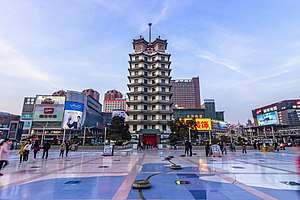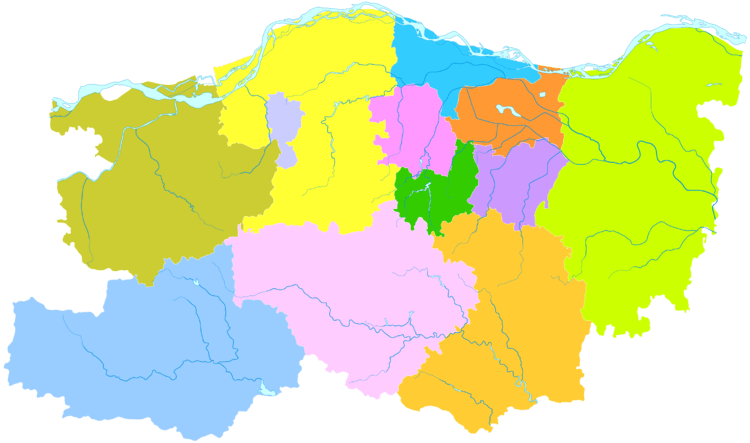1938 Yellow River flood
The 1938 Yellow River flood (traditional Chinese: 花園口決隄事件; simplified Chinese: 花园口决堤事件; pinyin: huāyuán kǒu juédī shìjiàn, literally "Huayuankou embankment breach incident") was a flood created by the Nationalist Government in central China during the early stage of the Second Sino-Japanese War in an attempt to halt the rapid advance of Japanese forces. It has been called the "largest act of environmental warfare in history".[1][2]
 Yellow River flooded area (1938) | |
| Location | Central China |
|---|---|
| Deaths | 893,303 deaths |
| Property damage | 3,911,354 of refugees Thousands of villages were inundated or destroyed and 12 million affected |
Strategic decision and the flood
Following the onset of the Second Sino-Japanese War in 1937, the Imperial Japanese Army marched rapidly into the heart of Chinese territory. By June 1938, the Japanese had control of all of North China. On June 6, they captured Kaifeng, the capital of Henan, and threatened to take over Zhengzhou, the junction of the arterial Pinghan and Longhai Railways. Japanese success here would have directly endangered the major city of Wuhan.
To stop further Japanese advances into western and southern China, Chiang Kai-shek, at the suggestion of Chen Guofu, determined to open up the dykes on the Yellow River near Zhengzhou. The original plan was to destroy the dyke at Zhaokou, but due to difficulties at that location, the dyke at Huayuankou, on the south bank, was destroyed on June 5 and June 7 via excavation,[3] with waters flooding into Henan, Anhui, and Jiangsu. The floods covered and destroyed thousands of square kilometres of farmland and shifted the mouth of the Yellow River hundreds of kilometres to the south. Thousands of villages were inundated or destroyed and several million villagers driven from their homes and made refugees. An unknown number of Japanese soldiers were killed by the flood. An official Kuomintang post-war commission estimated that the total number of casualties may be as high as 800,000 killed by the flood.[4]
Controversy over the strategy
The strategic value of the flood has been questioned. Japanese troops were out of its range, either to the north and east or to the south. Their advance on Zhengzhou was halted, but they took Wuhan in October by attacking from a different direction. The Japanese did not occupy much of Henan until late in the war and their hold on Anhui and Jiangsu remained tenuous. Most of the towns and transport lines in the areas which were flooded had already been captured by the Japanese; after the flood, they could not consolidate their control over the area, and large parts of it became guerrilla areas.[5]
Controversy over the number of casualties
The number of casualties in the flood remains disputed and estimates have been revised by the Chinese government and other researchers in the decades after the event. There is no way of accurately assessing the casualties: much of the population, including officials, had already fled, leaving no government control and no one to count the dead. In the shifting battles between bandits, Nationalists, Communists, and Japanese, counting casualties was not a high priority. The Nationalist government, after initially claiming that the breach was caused by Japanese bombing, used the heavy casualties to demonstrate the scale of sacrifice required of the Chinese people; it claimed that 12 million people had been affected by the flood, and in 1948 it estimated the number of deaths including hundreds of thousands of Japanese who perished during the flooding at 800,000. A 1994 PRC (People's Republic of China) official history of the war put the dead in the flood at 900,000 and the refugees at nearly 10 million. Scholars exploring the archives now give much lower figures: 400,000–500,000 dead, 3 million refugees, and 5 million people affected (another estimate puts the number of dead at 500,000, and the number of homeless at 500,000).[5]
Aftermath
Besides the massive death toll, the flooded areas were affected for years to come. The flooded countryside was more or less abandoned and all the crops destroyed. Upon the recession of the waters, much of the ground was uncultivable as much of the soil was covered in silt. Many of the public structures and housing were also destroyed, leaving any survivors destitute. The irrigation channels were also ruined, further adding to the toll on the farmlands.[5] The destruction also had a long-term psychological effect on the Chinese population. Unable to fully decide which group deserved more blame for the catastrophe, the Chinese Government or the invading Japanese, many survivors blamed both sides. However, because there were many Chinese civilians killed during the flood by the KMT, most of the civilians residing in that area began to cooperate with the Japanese. Believing that the civilians would help them, the Chinese Communists turned the flooded area into a recruiting ground, directing survivors' anger towards a common enemy to bring them into their ranks. By the 1940s the area had evolved into a major guerrilla base known as the Yuwansu Base Area.[5]
Repairs
Attempts to seal the breach and return the river to its former course were made in 1946, by the KMT with assistance from UNRRA. Work began in March and were complete in June, but the dams were destroyed by large summer flows.[6] Subsequent repairs succeeded and completed in March 1947.
The repairs became a political issue between the KMT and CPC; the KMT controlled areas around the breach whereas the CPC controlled the areas around the original downstream course. The river's pre-1938 bed had become a productive swath of farmland populated by 400,000 people; there were disputes around relocating and compensating these people, and whether to complete downstream dykes before sealing the breach.[5][7]
See also
| Wikimedia Commons has media related to 1938 Yellow River flood. |
- 1938 Changsha Fire
- Chinese famine of 1942–43
- 1941 eastern Ukraine floods during WW2
- Indian famine of 1943
- National Revolutionary Army
- Military of the Republic of China
- Military history of China
- Military history of Japan
Sources
- Diana Lary, "The Waters Covered the Earth: China's War-Induced Natural Disaster," in Mark Selden and Alvin Y. So, ed., War and State Terrorism: The United States, Japan, and the Asia-Pacific in the Long Twentieth Century (Rowman & Littlefield, 2004): 143–170.
References
- Dutch, Steven I. (November 2009). "The Largest Act of Environmental Warfare in History". Environmental & Engineering Geoscience. 15 (4): 287–297. doi:10.2113/gseegeosci.15.4.287.
- Muscolino, Micah S. (2014). The Ecology of War in China: Henan Province, the Yellow River, and Beyond, 1938–1950. Cambridge University Press.
- "Yellow River flood, 1938-47 | DisasterHistory.org". www.disasterhistory.org. Retrieved 2017-10-09.
- Taylor, Jay (2009). The Generalissimo: Chiang Kai-Shek and the Struggle for Modern China. Cambridge, Massachusetts: Belknap Press of Harvard University Press. pp. 154–155.
- Lary, Diana (1 April 2001). "Drowned Earth: The Strategic Breaching of the Yellow River Dyke, 1938". War in History. 8 (2): 191–207. doi:10.1177/096834450100800204. 1082337951.
- Institution of Water Engineers (1947). Water and Water Engineering. Fuel & Metallurgical Journals Limited. p. 312.
- Muscolino, Micah S. (2015). The Ecology of War in China Studies in Environment and History. New York, NY: Cambridge University Press. p. 202. ISBN 9781107071568. OCLC 894557470.

